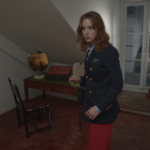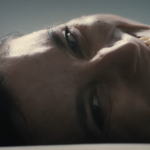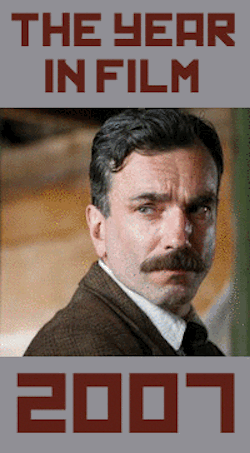Home Video Hovel: Life of Riley, by Dayne Linford
It’s definitely fitting that Alain Resnais should end his career with a cinematic exercise in obfuscation, but even for his tastes, Life of Riley is an astoundingly multilayered film. An adaptation, Resnais’ third, of a famously post-modern English playwright, translated into French, but retaining the setting in England, a country we only see in rolling location shots down country roads, which then fade into postcard drawings of estates, which fade into an assortment of gardens that are clearly sets, complete with curtains, with characters whose close-ups are against a cross-hatched background reminiscent of 50s style newspaper comics, the film is very nearly an assault on cinematic conventions, an exercise in uncovering, through obfuscation, human emotional truth. As such, Resnais extends the self-knowing conceit of his source material to an absurd degree, making the camera lens itself a fourth wall.
Riley is an ensemble piece, concerning three couples in some way attached to the titular character, George Riley, who, following a theatrical convention nearly a century old, we never see. We discover in the first scene that Riley has cancer and only months to live. Meanwhile, these six people scurry about attempting to define themselves in relation to him and his mortality, their own lives in danger of collapse. Resnais, until the last shot, insists on playing against this discussion of mortality, perhaps thereby making the most profound statement concerning our relationship to it possible.
He highlights the conventions of cinema as a way of simultaneously self-consciously exposing the dialogue of the film and thus, by playing against and often giving the lie to the characters, expose their own competing internal dialogues. Riley, the center around which these characters revolve, is no saint, and the specter of his mortality only makes him more self-centered, playing the doubts, fears, and tendernesses of the characters against each other in a seeming parade to his importance, which was practically non-existent prior to his diagnosis. Being unseen, the play has no center even as the characters insist on circling, and the film aggravates this further by highlighting the artificiality of their world, their lives, their emotions. As Riley dies, all the characters can consider is a mad dash for meaning, which he holds before them like a bone before dogs.
And, yet, the film really isn’t as cruel as that. It’s funny, heartfelt, light. Resnais uses the construct of artificiality to cleave through the artificial elements of these people, forcing a reckoning with themselves. Even as this occurs, though, he pushes back against it, playing these moments of painful nakedness or sweet reconciliation against new backdrops, characters marching through curtains as if doorways to an interior devoid of decoration to argue and plead over infidelity; tenderness and honesty played out, once more past curtains, on a staircase against a wall with myriad painted clocks, still yet chiming. He here highlights the constructed nature of human memory and experience, the way these constructs break down even as we build more, our convictions of the central truth of our memories and emotions played out in close-up against glaring cross-hatches that suggest our soliloquies, supposedly ourselves at our most truthful, are really ourselves at our most constructed.
But what’s wrong with that? Each blow and cruelty seems to land softly on our constructions, the death of Riley the only seeming permanent thing, the rest accrued and cast off as needed. They’re all small, pathetic, tender attempts at happiness that bump up against each other in a cacophony of sound and fury, signifying nothing, like a bunch of out of tune clocks.



























